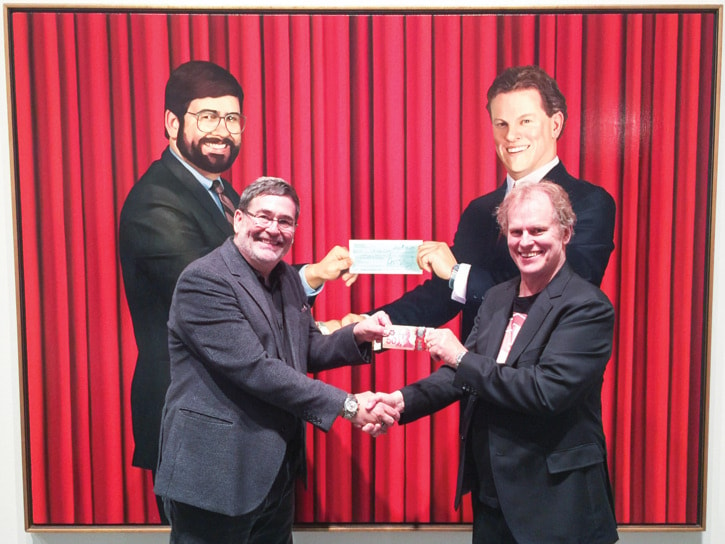Chris Cran has a one-word answer when asked how he feels about being described as a “renowned artist.”
“Good” – followed by a lengthy pause and an infectious burst of laughter.
Raised in Salmon Arm, Cran has plenty to laugh about – a new exhibition of his work opened Friday at the Art Gallery of Alberta in Edmonton and another one launches at the Southern Alberta Art Gallery in Lethbridge on Sept. 26.
On May 12, 2016, a collection of some 140 works from both exhibits will open at the National Art Gallery in Ottawa.
As well, Cran’s work, much of it with a playful twist, may be found in numerous private and public collections including the National Gallery of Canada, Canada House in London, England, the Glenbow Museum, the Nickle Arts Museum, and the Art Gallery of Alberta.
Cran is represented by TrépanierBaer Gallery in Calgary, Clint Roenisch Gallery in Toronto, and Wilding Cran Gallery in Los Angeles, which was founded by his son Anthony and wife Naomi Wilding.
Early in 2014, Cran received the prestigious Cultural Leaders Legacy Artist Award, established to honour artists who are lauded for their work in national and international arenas and choose to make Calgary their home.
Cran credits his longtime friend Herald Nix with setting his artistic course.
“He was painting from the age of 12 and I watched what he did,” Cran says. “He went to art school at 15 and at some point he said, ‘why don’t you try this?’ I did and was hooked.”
Cran says Nix gave him some paint and canvas and, while he is dismissive of his initial efforts, he persevered.
At the same time, Cran enrolled in the Ontario Institute for Studies in Education with a career in film in mind, but says he soon realized if he was going to pursue a career in the arts, it wasn’t going to be with other people.
Recalling a childhood of playing and tinkering around in a big old barn on the family homestead reminded Cran that he enjoyed doing what he wanted to do on his own.
Cran enrolled in the Kootenay School of the Arts in 1975 and remembers two important events that happened soon after – his fifth child was born and talented Shuswap artist Steve Mennie shared his realist techniques.
“For my second year, I moved to the Calgary School of Art and Design and, to help pay the bills, I did portrait commissions… using techniques I learned from Steve,” he says, noting that life took another twist with a marriage breakup and a post-college job of reading water and electric meters for the City of Calgary. “I started doing more commissions and big self-portraits, and that’s what got my career started.”
The above photo was taken at last Friday’s opening at the Art Gallery of Alberta and comes with an amusing Cran story. He had been doing a series of self portraits in the late ’80s when Toronto businessman Peter Boyd expressed an interest in his paintings.
“I had nothing available but had this idea and he agreed, so he flew out from Toronto and I took all the photos I needed to work from,” laughs Cran, noting Boyd hung the 182.9-x-243.8-centimetre painting in his living room, facing a large window. “Cars would stop and look and one day someone knocked on the door and asked what was going on.”
Boyd later moved to Calgary and donated the painting to the University of Lethbridge Art Gallery, which has loaned the piece for Cran’s Edmonton exhibition.
After the self-portraits, Cran started striped paintings with half-tone dots – a series of big heads 9 feet by 6 feet in size.
“I found images that were half-an-inch or an inch in old pulp magazines and blew them up, so close up, you only see dots,” he says, noting the viewer has to move farther away in order to see images
Next came a period of painting abstracts, followed by ink works where he was putting ink down and using an airbrush to blow the ink, or scraping or rolling.
Cran says the works begin to take on photographic qualities, a process he began to use to trick his viewer.
“I am trying to basically duplicate the photographic code…” he says, noting his excitement about people’s response. “They’d say it looks photographic and I’d say ‘Bingo!’
Cran has begun incorporating fine stencils of his own making into his art. When he’s had enough of cutting stencils, he picks up his paintbrush.
“When I do too much of one thing, I will go back and do some abstracts and then come back to the stencils,” he says.
Inspiration for his art is primarily visual.
“There’s a world of inspiration. I am sitting on the fourth floor of the Art Gallery (of Alberta) and there are dots on the screens on the windows,” he says looking at the play between the screens and a building beyond. “I look at the building and the dots are huge and I think, how can I use that?”
It is his innate curiosity that leads Cran to continue to explore ways of creating art.
“I get an idea and then I can make it. And then I get to see it,” he says. “It’s got to do with the pleasure of making… I never know what’s going to come next. It’s hard to beat.”
